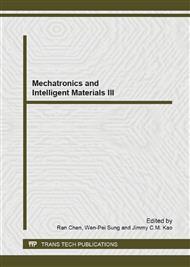[1]
X. M. Zhang, 2003, "Topology optimization of compliant mechanisms", Chinese journal of mechanical engineering, 39(11), pp.47-51. (In Chinese)
Google Scholar
[2]
StadlerW. 1984,"Multicriteria optimization in mechanics",Applied Mechanics Review,37,pp.277-286.
Google Scholar
[3]
Eschenauer H., Koski J., Osyczka A., 1990, "Multicriteria design optimization", Procedures and applications,Berlin:Springer.
DOI: 10.1007/978-3-642-48697-5
Google Scholar
[4]
Min S., Nishiwaki S., Kikuchi N., 2000, "Unified topology design of static and vibrating structures using multiobjective optimization", Computers and Structures, 75, pp.93-116.
DOI: 10.1016/s0045-7949(99)00055-3
Google Scholar
[5]
Chen T.Y., Shieh C.C., 2000, "Fuzzy multiobjective topology optimization", Computers and Structures, 78, pp.459-466.
DOI: 10.1016/s0045-7949(00)00091-2
Google Scholar
[6]
Chen T.Y., Wu S.C., 1998, "Multiobjective optimal topology design of structures", Computational Mechanisc, 21, p.483–492.
Google Scholar
[7]
X. M. Zhang, Y. J. Chen, 2006, "Topology optimization of multiple inputs and outputs compliant mechanisms with coupling terms control", Chinese journal of mechanical engineering, 42 (3) :pp.162-165. (In Chinese)
DOI: 10.3901/jme.2006.03.162
Google Scholar
[8]
Frecker M I, Kikuchi N, Kota S. Topology optimization of compliant mechanisms with multiple outputs. Structural Optimization, 1999, 17: p.269~278
DOI: 10.1007/bf01207003
Google Scholar
[9]
Pedersen C B W, Buhl T, Sigmund O. 1999, "Topology synthesis of large-displacement compliant mechanisms",In 1999 ASME Design Engineering Technical Conference, Las Vegas. DETC99/DAC-8554.
DOI: 10.1115/detc99/dac-8554
Google Scholar
[10]
Sigmund O. Design of Multiphysics Actuators using Topology Optimization—Part I:One-material Structures.Computer Methods in Applied Mechanics and Engineering, 2001,190(49-50):p.6577~6604.
DOI: 10.1016/s0045-7825(01)00251-1
Google Scholar
[11]
Gea H C, Luo J H. 2001, "Topology optimization of structure with geometrical nonlinearities", Computers and Structures, 79, pp.1977-1985.
DOI: 10.1016/s0045-7949(01)00117-1
Google Scholar
[12]
Buhl T, Pedersen C B W, Sigmund O. 2000, "Stiffness design of geometrically non-linear structures using topology optimization", Structural Optimization, 19(2), pp .93-104.
DOI: 10.1007/s001580050089
Google Scholar
[13]
Sigmund O. 1997, "On the design of compliant mechanisms using topology optimization", Mechanics of Structures and Machines, 25(4), pp.495-526.
DOI: 10.1080/08905459708945415
Google Scholar
[14]
Frecker M I, Ananthasuresh G K, Nishiwaki S, Kota S. Topological synthesis of compliant mechanisms using multi-criteria optimization. Transactions of the ASME, Journal of Mechanical Design, 1997, 119(2): p.238~245.
DOI: 10.1115/1.2826242
Google Scholar
[15]
X. M. Zhang, Y. J. Chen, 2005, "Topology and actuation elements optimization of compliant mechanisms with coupling terms control", Chinese journal of mechanical engineering, 41 (8) :pp.69-74. (In Chinese)
DOI: 10.3901/jme.2005.08.069
Google Scholar
[16]
Svanberg K. 1987, "The method of moving asymptotes: a new method for structural optimization", International Journal for Numerical Methods in Engineering, 24, pp .359-373.
DOI: 10.1002/nme.1620240207
Google Scholar
[17]
Diaz A R, Sigmund O. 1995, "Checkerboard patterns in layout optimization", Structure Optimization, 10(1), pp.40-45.
DOI: 10.1007/bf01743693
Google Scholar
[18]
Y. J. Chen, 2005, "study on integrated design of topology optimization of compliant mechanism and layout of actuator", Shantou university (D). (In Chinese)
Google Scholar
[19]
Zhaokun Li, Xianmin Zhang," Topology optimization of compliant mechanisms with geometrically nonlinear", International Technology and Innovation Conference 2006-Advanced Manufacturing Technologies, 2006,11: pp.477-482
DOI: 10.1049/cp:20060808
Google Scholar
[20]
Zhaokun Li, Xianmin Zhang," Multiobjective topology optimization of compliant microgripper with geometrically nonlinearity", ASME Proceedings of MNC2007, 2007,1: pp.101-107
Google Scholar


